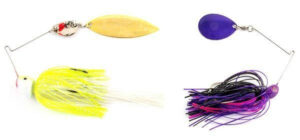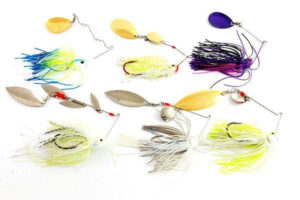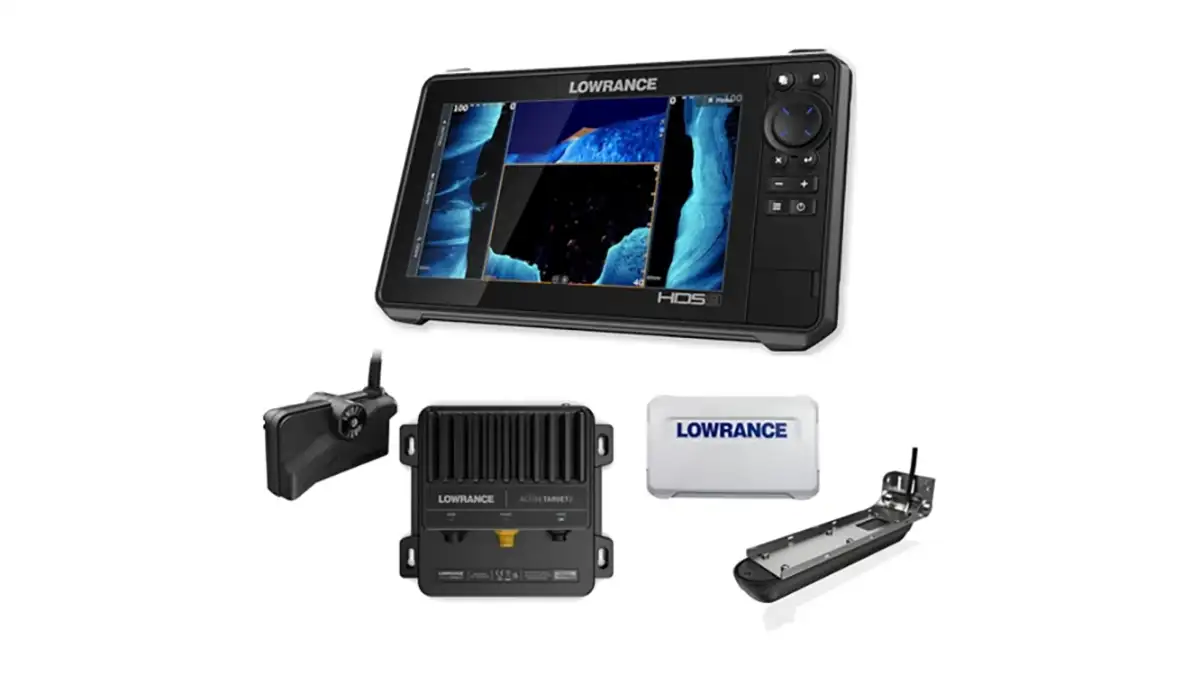A bass fishing spinnerbait is nothing more than a lead head molded onto a hook with an elbowed wire forming an arm that holds 1, 2, or up to 4 blades. It’s another lure that is worked with reel rather than the rod as much. As you wind the lure in, the blade or blades spin either on a swivel or around the arm itself causing a vibration and drag on the lure.
Blades are the key
There are a lot of options with spinnerbait blades. The three major types or shapes of blades are willow leaf, Colorado, and Indiana. There have been some other variations of blades over the year, but about 95% of the spinnerbaits you see will have one of these three blades or a combination of them. A willow leaf is a long slender blade, rounded with points on either end. These blades will spin faster, and resist less water than a Colorado or Indiana. It makes them good for fishing around grass, and in clear water where you might want a faster retrieve so the bass doesn’t get as good a look at it.
A Colorado blade is rounded, more like a huge, wide teardrop. The blade spins slower and puts out a much harder thump in the water than a willow leaf blade. It makes this a good choice for dingy or muddy water, and also especially at night. Single bladed short arm spinnerbaits have become staples for nighttime bass fishing. Anglers will often choose black or dark colored skirts with a black painted blade for nighttime angling. But a bright colored blade and bright skirt can be affective with Colorado blades in muddy water during the day.
The Indian blade is somewhat of a compromise between the willow leaf and the Colorado blade. It offers good thump but it is more streamlined than a standard Colorado blade.
Generally speaking the narrower the blades the better a spinnerbait comes through sparse grass. The larger blades give the bait more lift and make it work better round stumps, rocks, laydowns and other cover fairly well with minimal hangups.
Weight, retrieves and blades affect depth
Spinnerbaits will range in weight from 1/8 ounce to 2 ounces. The lighter spinnerbaits are made more for shallow ponds and such while the heavier cousins are made for fishing along the bottom in deep water on large reservoirs. Typically speaking with the same weight spinnerbait, the faster you reel, the shallower the spinnerbait will run. The slower you reel, the deeper it will run.
Blade size can also affect running depth of a spinnerbait. The bigger and rounder the blade, the more the bait wants to lift or come to the surface. The smaller and narrower the blades, the less lift the bait has and it will stay deeper on a slower retrieve. You often see ledge spinnerbaits with single willow leafs, while shallow spinnerbaits for muddy water will have to big Colorado blades.
You can add a trailer to the hook for more buoyancy and flare and to give the bait more profile for the fish to hone in on the strike.
Keep colors simple
Again there are rainbows of colors for spinnerbaits. But we advise keeping it simple. Go with a clear shad type color, a brighter chartreuse and white combination and maybe a black spinnerbait for night fishing and really muddy water. The clearer the water, the less you want the fish to see of the bait and fish it fast. The muddier the water the more contrast and color you want to help the bass be able to hone in on it.
Some angler favor painted blades. We keep some spinnerbaits with painted white and painted chartreuse blades in our spinnerbait box just in case. We have had some great days with painted blades but not all the time. In the midwest, many anglers are found of a painted kicker blade. So they might have a big willow leaf blade and then a small Colorado blade painted orange or red to just give an extra flash to it.
Conditions for spinnerbaits
Wind is your friend with a spinnerbait. The calmer, sunnier and clearer the water, the less productive spinnerbaits can be in shallow water. But it can be effective in deep water on bright sunny days. Typically reaction baits are more productive in cloudy windy conditions than on calm clear days. It can be a great search tool to tell you if active bass are in an area. You can cover big flats quickly with a spinnerbait. You can pull it through sparse grass, bump it into stumps, fish it down the sides of docks and pull it over rocks out deep. It’s a great multipurpose tool for a lot of scenarios in bass fishing.
A spinnerbait gives anglers another great lure to draw fish in with the flash of the blades and vibration. It works great in clear water and muddy water alike. Generally anglers will fish it faster the clearer the water and slower the muddier the water. It’s great slow rolled in 20 feet of water or waked under the surface in 1 foot of water. It’s extremely versatile.
For a better idea of when to use each lure in your tackle box, check out our Bass Fishing Lure Selector Chart. For more information on bass fishing, see our How to Bass Fish Guide, When to Bass Fish Guide and Where to Bass Fish Guide.
















